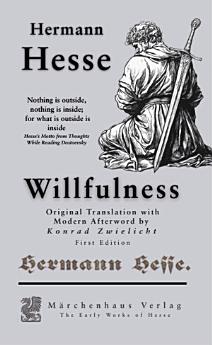Willfulness: With Alemannic Confession
The Early Works of Hermann Hesse Book 44 · Marchen Press
Ebook
85
Pages
family_home
Eligible
info
reportRatings and reviews aren’t verified Learn More
About this ebook
Composed in Bern during the war and published in 1919 in Vivos voco : Zeitschrift für neues Deutschtum under the pseudonym Emil Sinclair, Willfulness belongs unmistakably to the Demian period, where the themes of inner law, resistance, and solitude rise to the surface in sharper outline. The piece is not just autobiographical in tone—it is a declaration, a refusal to submit to the soft coercions of nation, family, and tradition. Written during Hesse’s self-imposed Swiss exile, the text responds to the Weimar Republic’s birth pangs—street battles between Spartacists and Freikorps, hyperinflation’s erosion of stability—by framing stubbornness as both pathology and praxis. Hesse draws on his own clashes with wartime censorship and bourgeois conformity, arguing that individual recalcitrance, however socially disruptive, safeguards inner autonomy against coercive ideologies. The essays’ tone, oscillating between polemic and introspection, mirrors the era’s fractured psyche, where rigid dogma clashed with anarchic disillusionment. Hesse’s concept of Eigensinn, sometimes translated as “self-will”, "obstinance", "stubbornness" or “inner independence,” emerges in his writings around 1917 as a response to the horrors of war and the moral crisis of his time. “Stubornness” is how Eigensinn is normally translated, but it does not have so much of a negative connotation. Amid widespread suffering and brutality, Hesse called for a transformation not through political upheaval or violent resistance, but through personal integrity and spiritual awakening. In his anonymous pamphlet from that era, he urges, “You must learn to be yourselves.” This call for individuality was not about egoism, but rather about resisting conformity to destructive systems. Hesse believed that true peace begins when individuals develop the courage to follow their conscience rather than blindly obey societal norms, especially those that promote violence. Alemannic Confession (Alemannisches Bekenntnis) was also written during Hesse’s self-imposed exile in Switzerland, but published posthumously. It comments on the political fractures of a Europe reshaped by nationalism, particularly between Germany, Austria and Switzerland. The text champions the Alemannic region’s cultural distinctiveness—its dialects, folklore, and agrarian traditions—as a counterpoint to the centralized German state emerging from the war’s ruins. Hesse, disillusioned by wartime propaganda, frames local identity as a bulwark against homogenizing ideologies, drawing parallels to the era’s rising regionalist movements in Bavaria and Alsace. The essay’s timing, coinciding with the Weimar Republic’s turbulent birth, underscores its implicit critique of top-down governance and industrial modernity’s erosion of rural life. "Alemannic Confession" shows Hesse locating cultural belonging not in the nationalist German state that had prosecuted the war, but in the older, more localized Alemannic heritage of southwestern Germany and northern Switzerland. The Alemannic region, with its distinct dialect and cultural traditions stretching back to medieval times, offered Hesse an alternative form of identity—one rooted in landscape, language, and local custom rather than political ideology or state power. Though rooted in Swabian nostalgia, Alemannic Confession resonated with postwar intellectuals grappling with cultural dislocation. Its emphasis on place-bound traditions mirrored contemporaneous efforts to revive prewar folk practices as antidotes to urban alienation. The work’s historical significance lies less in its literary merit than in its prescient defense of cultural pluralism, anticipating 20th-century debates about globalization and regional autonomy. Together, these two works are powerful commentary on the political, social and religious climate in wartime Europe. This new edition features an original contemporary translation of Hesse's early work, making his philosophical, existentialist literature accessible to modern readers from the original manuscripts. Enhanced by an illuminating Afterword focused on Hesse's personal and intellectual relationship with Carl Jung, a concise biography, a glossary of essential philosophical terms integral to his writings (his version of Jungian Psychological concepts) and a detailed chronology of his life and major works, this robust edition introduces the reader to the brilliance of his literature in context. It not only captures the depth and nuance of Hesse’s thought but also highlights its enduring impact on the debates of the mid-20th century, contemporary culture and Western Philosophy across the 20th and into the 21st century.
About the author
Herman Hesse (1877-1962) navigated a life shaped by psychological turbulence that fundamentally transformed his literary vision following his pivotal encounter with Carl Jung's analytical psychology. After suffering a severe breakdown in 1916 amid his crumbling first marriage and the ravages of World War I, Hesse underwent intensive psychoanalysis with Jung's student J.B. Lang and later with Jung himself, sessions that would profoundly alter his creative trajectory. This Jungian influence became evident in his subsequent works, particularly "Demian" and "Steppenwolf," where the protagonist's journey toward individuation—Jung's concept of integrating the conscious and unconscious aspects of personality—emerges as a central theme. Hesse's correspondence with Jung continued for decades, their intellectual relationship deepening as Hesse increasingly incorporated Jungian archetypes, dream symbolism, and the notion of the shadow self into his narratives of spiritual seeking. The writer later acknowledged that Jung's therapeutic methods had not only rescued him from psychological collapse but had fundamentally reshaped his understanding of human consciousness, enabling him to transmute his personal suffering into the allegorical quests for wholeness that characterized his most enduring works.RetryClaude can make mistakes. Please double-check responses.
Rate this ebook
Tell us what you think.
Reading information
Smartphones and tablets
Install the Google Play Books app for Android and iPad/iPhone. It syncs automatically with your account and allows you to read online or offline wherever you are.
Laptops and computers
You can listen to audiobooks purchased on Google Play using your computer's web browser.
eReaders and other devices
To read on e-ink devices like Kobo eReaders, you'll need to download a file and transfer it to your device. Follow the detailed Help Center instructions to transfer the files to supported eReaders.











